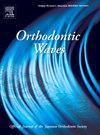上颌横向尺寸在南印度人群中有和没有埋伏犬的受试者:一项比较锥束计算机断层扫描研究
IF 0.5
Q4 DENTISTRY, ORAL SURGERY & MEDICINE
引用次数: 4
摘要
摘要目的:本研究的目的是评估单侧和双侧牙嵌塞受试者的上颌横向尺寸,并与相似的对照组进行比较,并建立相关性,如果有的话。材料与方法:本研究纳入135例受试者,分为3组:(i)单侧牙嵌塞组,(ii)双侧牙嵌塞组和(iii)对照组,每组45例。对于每个受试者,使用CBCT在以下4个水平上评估4个上颌横向尺寸:第一磨牙基宽(MBW),第一磨牙牙槽宽度(MAW)(图2),第一前磨牙基宽(PMBW)和第一前磨牙牙槽宽度(PMAW)。结果:双侧和单侧嵌塞组MBW、MAW、PMBW和PMAW均显著降低(p值<0.001)。结论:双侧和单侧嵌塞的上颌横向尺寸比无嵌塞的上颌横向尺寸窄。正畸医师在制定矫治计划时必须注意并考虑上颌横向宽度与牙嵌塞之间的关系。本文章由计算机程序翻译,如有差异,请以英文原文为准。
Maxillary transverse dimensions in subjects with and without impacted canines in South Indian population: a comparative cone-beam computed tomography study
ABSTRACT Aim: Aim of this study was to assess transverse maxillary dimension in subjects with unilateral and bilateral canine impaction, compare with a similar control group and to establish correlation, if any. Materials and Methods: This study included 135 subjects who were split into three groups: (i) unilateral canine impaction group, (ii) bilateral canine impaction and (iii) control group each having 45 subjects. For each subject 4 maxillary transverse dimensions were evaluated on the following 4 levels: first molar basal width (MBW), first molar alveolar width (MAW) (Figure 2), first premolar basal width (PMBW), and first premolar alveolar width (PMAW) using CBCT. Results: MBW, MAW, PMBW and PMAW were significantly reduced in groups with bilateral and unilateral canine impaction (p-value<0.001). Conclusion: It can be concluded that subjects with bilateral and unilateral canine impactions have narrower maxillary transverse dimensions than those without impaction. Orthodontists must be aware and should consider the relationship between transverse maxillary width and canine impaction during pedantic treatment planning.
求助全文
通过发布文献求助,成功后即可免费获取论文全文。
去求助
来源期刊

Orthodontic Waves
DENTISTRY, ORAL SURGERY & MEDICINE-
CiteScore
0.40
自引率
0.00%
发文量
0
期刊介绍:
Orthodontic Waves is the official publication of the Japanese Orthodontic Society. The aim of this journal is to foster the advancement of orthodontic research and practice. The journal seeks to publish original articles (i) definitive reports of wide interest to the orthodontic community, (ii) Case Reports and (iii) Short Communications. Research papers stand on the scientific basis of orthodontics. Clinical topics covered include all techniques and approaches to treatment planning. All submissions are subject to peer review.
 求助内容:
求助内容: 应助结果提醒方式:
应助结果提醒方式:


